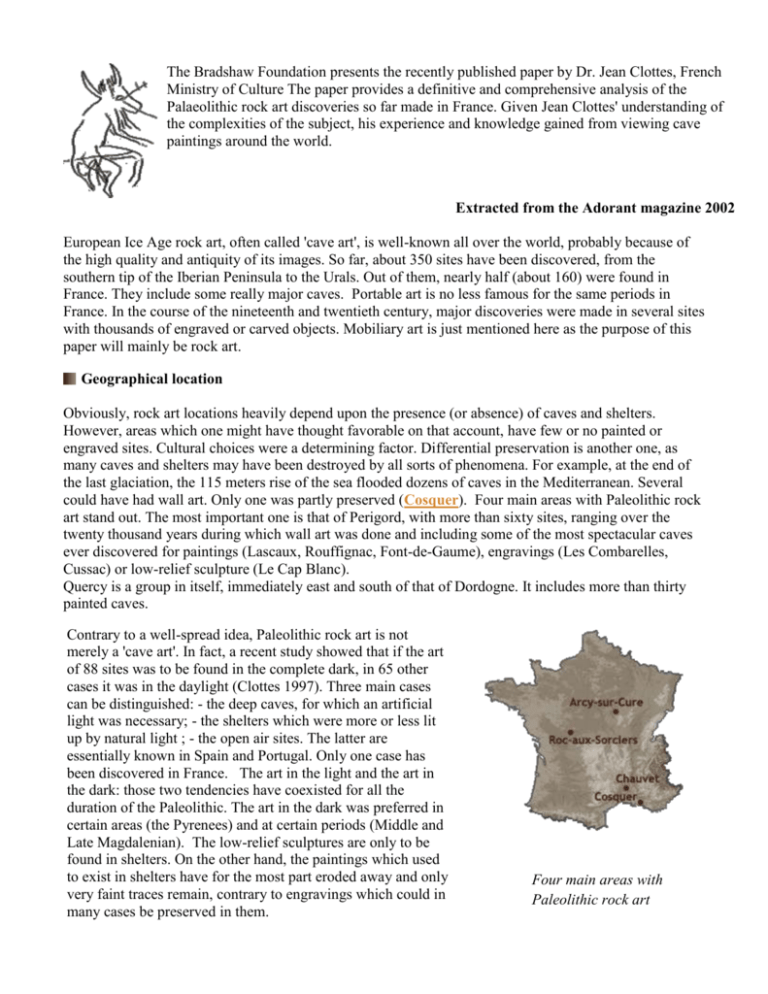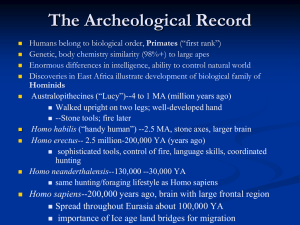Clottes article
advertisement

The Bradshaw Foundation presents the recently published paper by Dr. Jean Clottes, French Ministry of Culture The paper provides a definitive and comprehensive analysis of the Palaeolithic rock art discoveries so far made in France. Given Jean Clottes' understanding of the complexities of the subject, his experience and knowledge gained from viewing cave paintings around the world. Extracted from the Adorant magazine 2002 European Ice Age rock art, often called 'cave art', is well-known all over the world, probably because of the high quality and antiquity of its images. So far, about 350 sites have been discovered, from the southern tip of the Iberian Peninsula to the Urals. Out of them, nearly half (about 160) were found in France. They include some really major caves. Portable art is no less famous for the same periods in France. In the course of the nineteenth and twentieth century, major discoveries were made in several sites with thousands of engraved or carved objects. Mobiliary art is just mentioned here as the purpose of this paper will mainly be rock art. Geographical location Obviously, rock art locations heavily depend upon the presence (or absence) of caves and shelters. However, areas which one might have thought favorable on that account, have few or no painted or engraved sites. Cultural choices were a determining factor. Differential preservation is another one, as many caves and shelters may have been destroyed by all sorts of phenomena. For example, at the end of the last glaciation, the 115 meters rise of the sea flooded dozens of caves in the Mediterranean. Several could have had wall art. Only one was partly preserved (Cosquer). Four main areas with Paleolithic rock art stand out. The most important one is that of Perigord, with more than sixty sites, ranging over the twenty thousand years during which wall art was done and including some of the most spectacular caves ever discovered for paintings (Lascaux, Rouffignac, Font-de-Gaume), engravings (Les Combarelles, Cussac) or low-relief sculpture (Le Cap Blanc). Quercy is a group in itself, immediately east and south of that of Dordogne. It includes more than thirty painted caves. Contrary to a well-spread idea, Paleolithic rock art is not merely a 'cave art'. In fact, a recent study showed that if the art of 88 sites was to be found in the complete dark, in 65 other cases it was in the daylight (Clottes 1997). Three main cases can be distinguished: - the deep caves, for which an artificial light was necessary; - the shelters which were more or less lit up by natural light ; - the open air sites. The latter are essentially known in Spain and Portugal. Only one case has been discovered in France. The art in the light and the art in the dark: those two tendencies have coexisted for all the duration of the Paleolithic. The art in the dark was preferred in certain areas (the Pyrenees) and at certain periods (Middle and Late Magdalenian). The low-relief sculptures are only to be found in shelters. On the other hand, the paintings which used to exist in shelters have for the most part eroded away and only very faint traces remain, contrary to engravings which could in Geographical locationin them. many cases be preserved Four main areas with Paleolithic rock art In the shelters, there have most often been settlements next to the wall art. People lived there and went on with their daily pursuits close to the engravings, the paintings and low-relief sculptures. The case is quite different for the deep caves which usually remained uninhabited. This must mean that the art of the one and that of the other were probably not considered in the same way: in the deep caves the images were nearly never defaced, destroyed or erased, where as in the shelters the archaeological layers - i.e. the rubbish thrown away by the group - often ended up by covering up the art on the walls (Gourdan, Le Placard). The art inside the caves was respected, while the art in the shelters eventually lost its interest and protection. The themes chosen Whether for the art in the dark or for the art in the light, the themes represented are the same. They testify to identical beliefs, even if ritual practices may have varied according to the different locations. Above all, Paleolithic art, from beginning to end, is an art of animals. In the past few years, some specialists have insisted upon the importance of geometric signs. It is true that those signs and indeterminate traces are numerically more important than the animals and that they constitute one of the major characteristics of the art. Under their most elementary forms, as clouds of dots and small red bars, they can be found from the Aurignacian in Chauvet to the Middle and Late Magdalenian in Niaux. They are the most mysterious images in cave art. Very few caves have none, on the contrary, or have nothing but geometric signs; this means that those signs are practically always associated to animals, either in the same caves and often on the same panels or directly on top of them (G.R.A.P.P. 1993). However, our first and most durable impression of Paleolithic art is above all that of a bestiary, plentiful and various while remaining typical. Most of the animals represented are big herbivores, those that the people of the Upper Paleolithic could see around them and which they hunted. Those choices were not compulsory. They might have preferred to draw birds, fish or snakes, but they did not do so. Horses are most frequent in Paleolithic wall art in France. Photo by J. Clottes Bison are numerous in the Ariege Pyrenees as here in Niaux. Photo by R. Robert Horses are dominant. Locally they may be outnumbered by bison or hinds, occasionally even by rhinoceroses and lions at the very beginning or, much later, by mammoths at Rouffignac (Plassard 1999). None the less, they always remain numerous whatever techniques were used at any period and in any region. We might say that the theme of the horse is at the basis of Paleolithic rock art. This is all the more remarkable as that animal, even though present among the cooking debris of Paleolithic living sites, was often less plentifully killed and eaten than reindeer and bison, or again ibex in mountainous rocky areas. This means that it played a major role in the bestiary. The same could be said, even if less so, for the bison, whose images are also found in relatively high numbers from the Aurignacian to the end of the Magdalenian. The importance of animal themes varies according to the different regions but much more in function of the periods considered. For example, the enormous number of normally rare dangerous animals in the Chauvet Cave created a surprise: Chauvet Lions Chauvet Rhinoceroses rhinoceroses, lions, mammoths and bears represent 63% of the recognizable animal figures Lions (left) are rarely represented except at the beginning of (Clottes (ed.) 2001). However, Upper Paleolithic Art here in Chauvet (Vallon-Pont-d'Arc, this is not a unique phenomenon, Ardeche). Rhinoceroses (right) are also quite rare in general isolated in time and space. In the except at Chauvet. Photographs by Jean Clottes. Dordogne, at the same epoch, Aurignacians made use of the same themes in their shelters and their caves in much higher proportions than can be found in later art. This would mean that an important thematic change took place in the art of the south of France at the beginning of the Gravettian or at the end of the Aurignacian, when their choices changed from the most fearsome animals to the more hunted ones (Clottes 1996). Human representations can be found, but in far fewer numbers in comparison with the painted and engraved animals. About a hundred have been published, not counting hand stencils and hand prints or isolated female sexual organs. This numerical inferiority, constant at all times during the Upper Paleolithic, is in sharp contrast to what one can see in most forms of rock art all over the world. In addition to their relative scarcity, human representations evidence two main characteristics: they are nearly always incomplete or even reduced to an isolated segment of their body; they are not naturalistic, contrary to the animals. Whole human representations are exceptional, hardly a score. They may be carved women, or women sketched with a finger or a tool on the soft surface of a wall or ceiling, or painted or engraved men. The techniques utilized In France, only 18 sites are known with sculptures. The most important ones are Cap-Blanc in the Dordogne and the Roc-aux-Sorciers in the Vienne. That technique is the one that required most work. Some images evidence a 5 cm relief or more. It is present in all the main groups except that of the southeast. Clay modellings are all dated to the Middle or Late Magdalenian and they are all found within a restricted area, in four caves of the Ariege Pyrenees. Those in the latter two caves are famous, Montespan because of a clay bear which is a real statue, nearly lifesize, and Le Tuc d’Audoubert because of two extraordinary bison following each other in a premating scene. A particularly naturalistic female sex was modelled on the ground in Bedeilhac. It is difficult to understand why other works made with such a simple technique have not been found in other groups and at other periods. Statues of bison modelled in clay in Le Tuc d'Audobert. Photo R. Begouen (right) Artists Impression PreHistoric children. Finger tracings are everywhere. Their presence depends upon the qualities of the walls: when their surface is soft it becomes possible to draw with one’s fingers. Finger tracings are often not naturalistic, with volutes and incomprehensible squiggles that occupy many square meters on the walls and ceilings. Most frequently they belong to the earliest periods of the art. The engravings on the ground are more frequent in the Pyrenees than anywhere else. For them as for the paintings in the open preservation problems are vital: it is so easy not to notice them and to destroy them by trampling. This must have happened innumerable times. The engravings on the walls are less famous than the paintings because they are less spectacular, but they probably are more numerous. They were mostly made with a flint and the effects achieved are very diverse. Sometimes, the artists contented themselves with sketching the outlines of animals by means of simple lines which can be deep and wide or thin and superficial according to the hardness of the surface. The finest ones can only be seen now under a slanting light, but modern experimentation has shown that they must have been far more visible at the time they were made, when they stood out white against the darker color of the wall; since then they got patinated and their color is the same as that of their environment. This remark may explain the In Les Trois-Freres very numerous superimpositions of motifs that can be found in caves like Les (Montesquieu-Avantes, Trois-Freres, Lascaux or Les Combarelles. In other cases, the artists used Ariege), many engravings scraping, which shows white on the wall and enables all sorts of possibilities are superimposed. Tracing by playing with the darker hues of the wall and the lighter ones of engravings. H. Breuilt Paintings are generally red or black. The reds are iron oxides, such as hematite. The blacks, either charcoal or manganese dioxide. Sometimes they did real drawings with a chunk of rock or of charcoal held like a pencil. Elsewhere veritable paintings were made. The pigment was then crushed and mixed with a binder to ensure the fluidity of the paint which was then either applied with a finger or with a brush made with animal hair, or blown through the mouth (stencilling). Modern analyses even revealed that in the Magdalenian of the Pyrenees some paintings had been made according to real recipes by adding an extender, i.e. a powder obtained from the crushing of various stones (biotite, potassium feldspath, talcum). The aims were to save on the pigment, to make the paint stick better to the wall and to avoid its crackling when drying. Some images evidence different techniques for the same subject: bicolour, joint use of engraving & painting. As early as n 30,000+ years ago, the most sophisticated techniques of representation had been discovered and were in use, as can be seen in the Chauvet Cave. Those artists made use of stump drawing in order to shade the inside of the bodies and provide relief. They also used the main two colours (red and black), fine and deep engraving, finger tracing and stencilling. Chronology Until the end of the eighties, it was impossible to date paintings directly, as the quantity of pigment necessary for such an analysis was too important. Accelerator mass spectrometry now enables us to obtain a date with less than one milligram of charcoal. Consequently, a number of direct dates are now available for six French caves. When the caves have only got engravings or red paintings, or black paintings made with manganese dioxide, it remains impossible to get a direct date because of the lack of organic material. Chronological attributions are then made with time-honoured methods, generally by taking advantage of the archaeological context whenever possible or from stylistic comparison with other better dated sites. For example, when the Cussac cave was discovered in the Dordogne in October 2000, Norbert Aujoulat and Christian Archambeau attributed its engravings to the Gravettian because of the similarities with Pech-Merle and Gargas (Aujoulat et al. 2001). When, in August 2001, a 25,120 BP ±120 date was obtained from a human bone in the same cave, it corroborated the initial estimate of those specialists (op. cit.). Among well-established facts, the most important is the duration of cave art, over at least twenty millenia. The oldest dates are so far those of the Chauvet Cave (between 30,000 and 32,000 BP) and the most recent one that in Le Portel (11.600 ± 150 BP). Such an immense duration implies several consequences. First, the acknowledgement that in order for such a tradition to persist under such a formalized form for such a long time, it must have meant that a strong compelling form of teaching existed. The fundamental unity of Paleolithic art, obvious as it is in its images and in the activities around it, could not but for that have persisted for so many millenia. It is also a fact that the apparent great number of painted or engraved caves and shelters is not much when compared to the duration of Paleolithic art. This means that there must have been an art in the open which has not been preserved in France, and also that the images, in hundreds of shelters and caves may have been destroyed or buried and concealed for a number of reasons. Until a rather recent date, the evolution of art was believed to have been gradual. Recent discoveries have shown that that paradigm was wrong, since from as early as the Aurignacian and the Gravettian very sophisticated techniques had already been invented. This means that forms of art evidencing different degrees of mastery must have coexisted in different places and times and also that many artistic discoveries were made and lost and made again thousands of years later. The evolution of Paleolithic art was not in a straight line, but rather as a seesaw. Human and animal activities in the deep caves Paleolithic wall art cannot be dissociated from its archaeological context. This means the traces and remains of human and animal activities in the deep caves, because valuable clues about the actions of their visitors are better preserved in them than in any other milieu. Bears, particularly cave bears, hibernated in the deepest galleries. Some died and their bones were noticed by Paleolithic people when they went underground. At times they made use of them : they strung them along the way and lifted their impressive canines in Le Tuc d’Audoubert; in Chauvet, they deposited a skull on a big rock in the middle of a chamber and stuck two humerus forcibly into the ground not far from the entrance. Cave bears scratched the walls as bears do trees and their very noticeable scratchings may have spurred people to make finger tracings (Chauvet) or engravings (Le Portel). Jean Clottes examines the Skull Bear Skull Altar of Chauvet (left) In one of the biggest chambers of the Chauvet Cave, a cave bear skull was deposited on top of a rock. Photo J. Clottes (right) Jean Clottes examines the Bear Skull Altar. Humans left various sorts of traces, whether deliberately or involuntarily. When the ground was soft (sand, wet clay), their naked footprints remained printed in it. This enables us to see that children, at times very young ones, accompanied adults when they went underground, and also that the visitors of those deep caves were not very numerous because footprints and more generally human traces and remains, are few. The charcoal fallen from their torches, their fires, a few objects, bones and flint tools left on the ground are the remains of meals or of sundry activities. They are also part of the documentation left by prehistoric people in the caves. From their study, one can say that in most cases painted or engraved caves were not inhabited, at least for long periods. Fires were temporary and remains are relatively scarce. Naturally, there are exceptions. In their case, it is often difficult to make out whether those settlements are in relation - as seems likely - or not with the art on the walls. The presence of portable art may be a valuable clue to establish such a relationship. Among the most mysterious remains are the objects deposited in the cracks of the walls and in particular the bone fragments stuck forcibly into them (see also below). After being noticed in the Ariegie Volp Caves. those deposits have been found in numerous other French Paleolithic art caves. They belong to periods sometimes far apart, which is not the least interesting fact about them because this means that the same gestures were repeated again and again for many thousands of years. Thus, in Gargas, a bone fragment lifted from one of the fissures next to some hand stencils was dated to 26,800 BP, while in other caves they are Magdalenian i.e. more recent by 13,000 to 14,000 years. The Gravettian burials very recently discovered in the Cussac cave (Aujoulat et al. 2001) pose a huge problem. It is the first time that human skeletons have been found inside a deep cave with Paleolithic art. Until they have been excavated and studied properly it will be impossible to know whether those people died there by accident (which is most unlikely), whether they were related to those who did the engravings, whether they enjoyed a special status, etc. Their presence just stresses the magic/religious character of art in the deep caves. Meaning(s) Ever since the beginning of the twentieth century, several attempts have been made to find the meaning(s) of Paleolithic rock art. Art for art’s sake, totemism, the Abbe Breuil’s hunting magic and Leroi-Gourhan’s and Laming-Emperaires’s structuralist theories were proposed and then abandoned one after the other. Since then, most specialists have made up their minds that it would be hopeless to look for the meanings behind the art. They prefer to spend their time and efforts recording it, describing it and dating it, to endeavor to answer the questions 'what ?', 'how ?' and 'when ?', thus carefully avoiding the fundamental question 'why ?'. In the course of the past few years, though, a new attempt, spurred by David LewisWilliams, was made in order to discover an interpretative framework. Shamanism was proposed (Clottes & Lewis-Williams 1998). Considering the fact that shamanism is so widespread among hunter-gatherers and that Upper Paleolithic people were admittedly hunter-gatherers, looking to shamanism as a likely religion for them should have been the first logical step whenever the question of meaning arose. In addition, shamanic religions evidence several characteristics which can make us understand cave art better. The first one is their concept of a complex cosmos in which at least two worlds - or more - coexist, be they side by side or one above the other. Those worlds interact with one another and in our own world most events are believed to be the consequence of an influence from the other-world(s). The second one is the belief of the group in the ability for certain persons to have at will a direct controlled relationship with the other-world. This is done for very practical purposes: to cure the sick, to maintain a good relationship with the powers in the other-world, to restore an upset harmony, to reclaim a lost soul, to make good hunting possible, to forecast the future, to cast spells, etc. Contact happens in two ways: spirit helpers, very often in animal form, come to the shaman and inhabit him/her when he/she calls on them ; the shaman may also send his/her soul to the other-world in order to meet the spirits there and obtain their help and protection. Shamans will do so through trance. A shaman thus has a most important role as a mediator between the real world and the world of the spirits, as well as a social role. Upper Paleolithic people were Homo sapiens sapiens like us and therefore had a nervous system identical to ours. Consequently, some of them must have known altered states of consciousness in their various forms including hallucinations. This was part of a reality which they had to manage in their own way and according to their own concepts. This being said, we know as a fact that they kept going into the deep caves for twenty thousand years at the very least in order to draw on the walls, not to live or take shelter there. Everywhere and at all times, the underground has been perceived as being a supernatural world, the realm of the spirits or of the dead, a forbidding gate to the Beyond which people are frightened of and never cross. Going into the subterranean world was thus defying ancestral fears, deliberately venturing into the kingdom of the supernatural powers in order to meet them. The analogy with shamanic mind travels is obvious, but their underground adventure went much beyond a metaphoric equivalent of the shaman’s voyage : it made it real in a milieu where one could physically move and inwhich spirits were literally at hand. When Upper Paleolithic people went into the deeper galleries, they must have been acutely aware that they were in the world of the supernatural powers and they expected to see and find them. Such a state of mind, no doubt reinforced by the teaching they had received, was certain to facilitate the coming of visions that deep caves in any case tend to stir up (as many spelunkers have testified). Deep caves could thus have a double role the aspects of which were indissolubly linked: to make hallucinations easier; to get in touch with the spirits through the walls.








